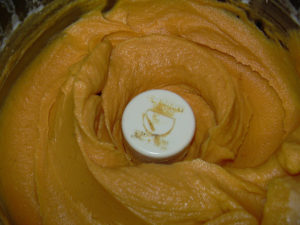 by Bianca Sams (from Finger Lickin’ Kitchen)
by Bianca Sams (from Finger Lickin’ Kitchen)
Are you staring at those Sweet Potatoes/Yams you bought for Turkey Day? Are you thinking they have to be laden with butter, sugar, and marshmallows to be good?
Well, I want to give a quick alternative called Sweet Potato Whip. It is truly a luscious side dish or dessert much lighter but so tasty.
Sweet Potatoes are naturally well sweet. You don’t need to cover them with ten pounds of butter and sugar to enhance that.
Try these simple switches to lower the calories while maintaining that luscious taste.
1) Steam the Sweet Potato instead of boiling to preserve nutrients
2) Try some natural sweets like honey, dates or try using something like blackstrap molasses and Grade B maple syrup. I have also cooked mine down with pineapple juice which also brings out their natural sweetness.
3) To achieve that oh so creamy taste that we crave without all that butter try fat free Greek Style yogurt or hemp/soy milk.
4) To boost flavor without the marshmallows, add real Vanilla extract, Cinnamon, nutmeg, clove, and a pinch of salt to bring out the sweetness already there.
5) If no one is allergic to nuts… chop some walnuts or pecans (my favorite). Throw them into the mix. It will help slow down the absorption of the sugar.
6) If you want a more savory rather than sweet side dish. Pair Sweet Potato with Butter nut squash. Cut into medium sized chunks. Add lots of parsley, garlic, onions, and sprinkle some salt & olive oil on them. Roast them in the oven until soft and Voila a savory sweet potato side dish.
Sweet Potatoes are packed with vitamin A, antioxidants, anti-inflammatory properties, not to mention they have a positive affect on your blood sugar. WHO KNEW? Many people think that starchy root vegetables are a food group that could not possibly be helpful for controlling their blood sugar.
The fear is normal because we now know that food starches can be converted by our digestive tract into simple sugars. If foods are especially concentrated in starch, there can often be a risk of too much simple sugar release in our digestive tract and thus too much pressure upon body to deal with more sugar.
What’s amazing about sweet potatoes is their ability to actually improve blood sugar regulation—even in persons with type 2 diabetes. Sweet potatoes contain a valuable amount of dietary fiber (just over 3 grams per medium sweet potato) and if boiled or steamed can carry a very reasonable glycemic index (GI) rating of approximately 50. Add the wonderful insulin regulating cinnamon to the mix and this seems like a wonderful and healthy option for a side dish.
I LOVE sweet potatoes in general but, especially during the holidays! And what’s not to love about these delicious morsels? But, making them healthy doesn’t mean you have to make them tasteless. Just make some tweeks and Viola…great taste that won’t expand your waistline or kill your blood sugar.
Gooble Gooble Everyone~
Bianca
Nutrition Tidbits
Sweet Potato: Vitamin A, Vitamin C, Manganese, Copper, Dietary Fiber, Vitamin B6, Potassium, and Iron. These root vegetables are often over looked as healthy treats but the Sweet Potato possesses powerful phytonutrients and pigments, anti-inflammatory vitamins and minerals, and help control blood sugar controlling. Vitamin A: preserves and improves eye sight and helps immune system fight off viral infections. Potassium: helps muscles and nerves function, keeps your electrolytes and acids in the body balanced, lowers risk of high blood pressure, and helps fight fatigue. Potassium, sodium and chloride comprise the electrolyte family of minerals. Called electrolytes because they conduct electricity when dissolved in water, these minerals work together closely.
Cinnamon: Manganese, Iron, Dietary Fiber, Calcium. Yes, it’s a spice but, did you also know it can help control blood sugar, may help improve brain function, keeps your heart and colon healthy, and is useful as an anti-inflammatory and has anti-microbial ability? Cinnamon slows the rate at which your stomach empties (slowing the rate in which sugars go into the blood stream and maintaining a steadier blood sugar level) and also stimulates your bodies insulin receptors (making it more efficient at utilizing the insulin in the body and therefore metabolize sugar better).
Cloves: Manganese, Omega 3, Vitamin K, Dietary fiber, Vitamin C, Magnesium, Calcium. Manganese is a little known trace mineral that does A LOT to keep us healty. It is vital to absorption of key nutrients (biotin, thiamin, ascorbic acid, and choline), keeps your bones strong, helps body utilize fatty acids and cholesterol, helps maintain healthy blood sugar, helps keep thyroid gland functioning properly, protects cells from free-radical damage, and helps keep our nerves healthy.
Nutmeg: Vitamin A, Vitamin C, Choline, Potassium, Calcium, Phosphorus, Magnesium, iron, zinc, copper, manganese, thiamin, riboflavin, niacin, Vitamin B6, folate and selenium. Nutmeg cures stomach aches, diarrhea and helps to detoxify the body, reduces blood pressure and increases blood circulation. It is also good for digestion, reducing acidity, relieving vomiting, flatulence and is used as a medicine for respiratory problems. Choline: keeps cell membranes (the walls that allow nutrients into cells and waste to leave cells) functioning normally, helps nerves and muscles communicate properly, keeps homocysteine levels from building up in blood stream (high levels linked to cardiovascular disease and osteoporosis ), reduces chronic inflammation. Thiamin/ B1: helps maintain energy, coordinates activity between nerves and muscles, supports heart function.